Charles E W Bean, Diaries, AWM38 3DRL 606/260/1 - 1916 - 1930 - Part 7
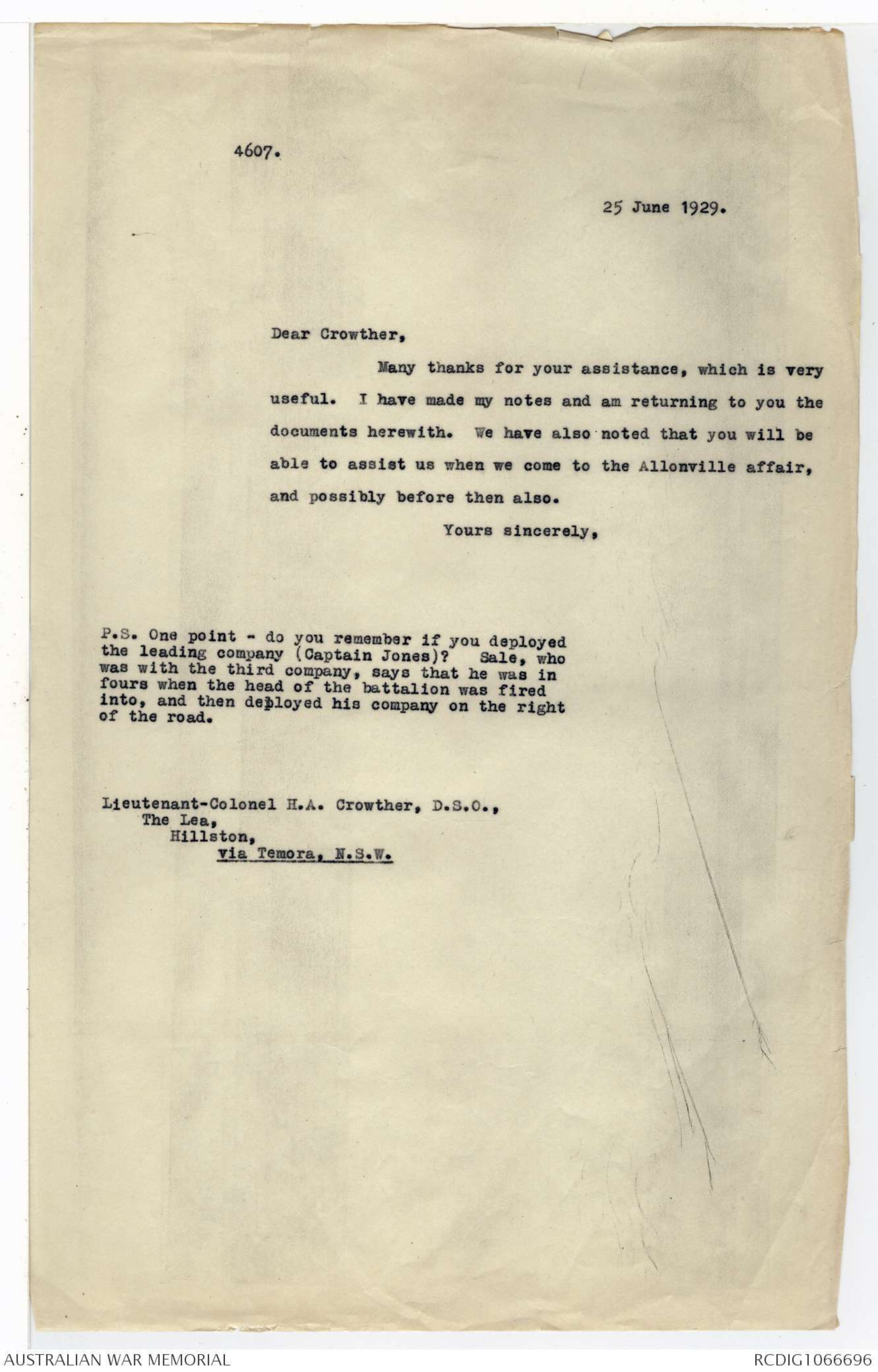
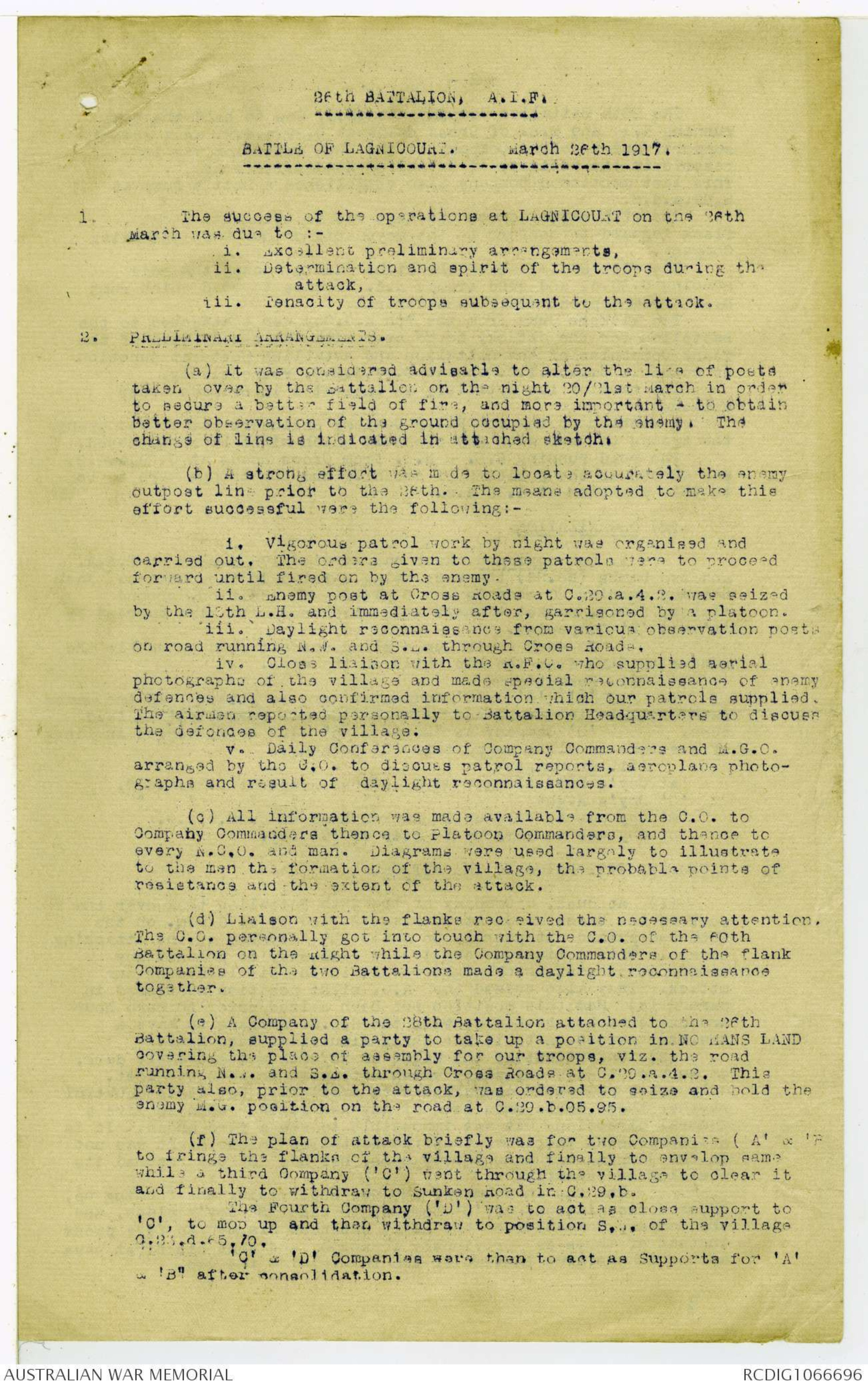
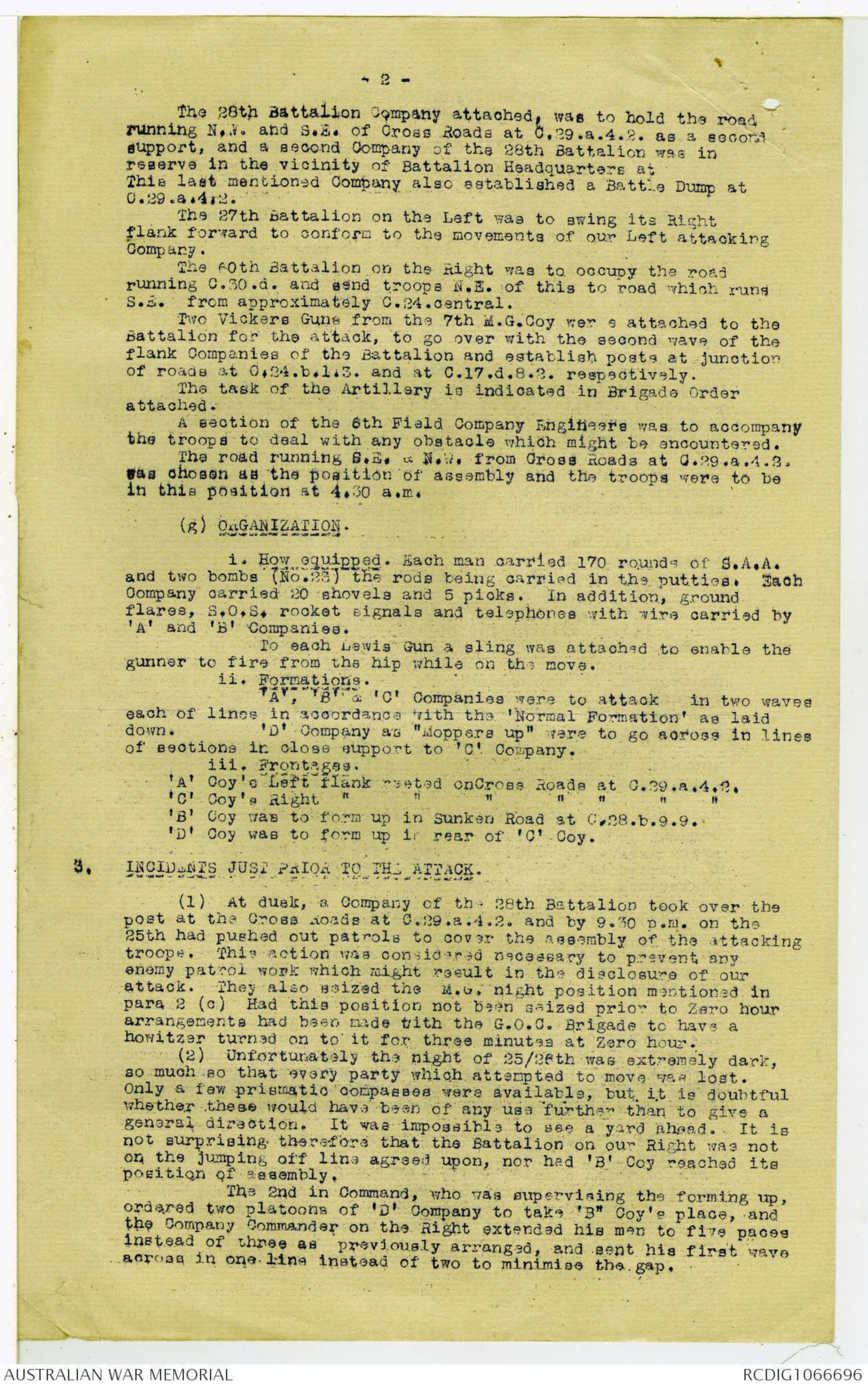
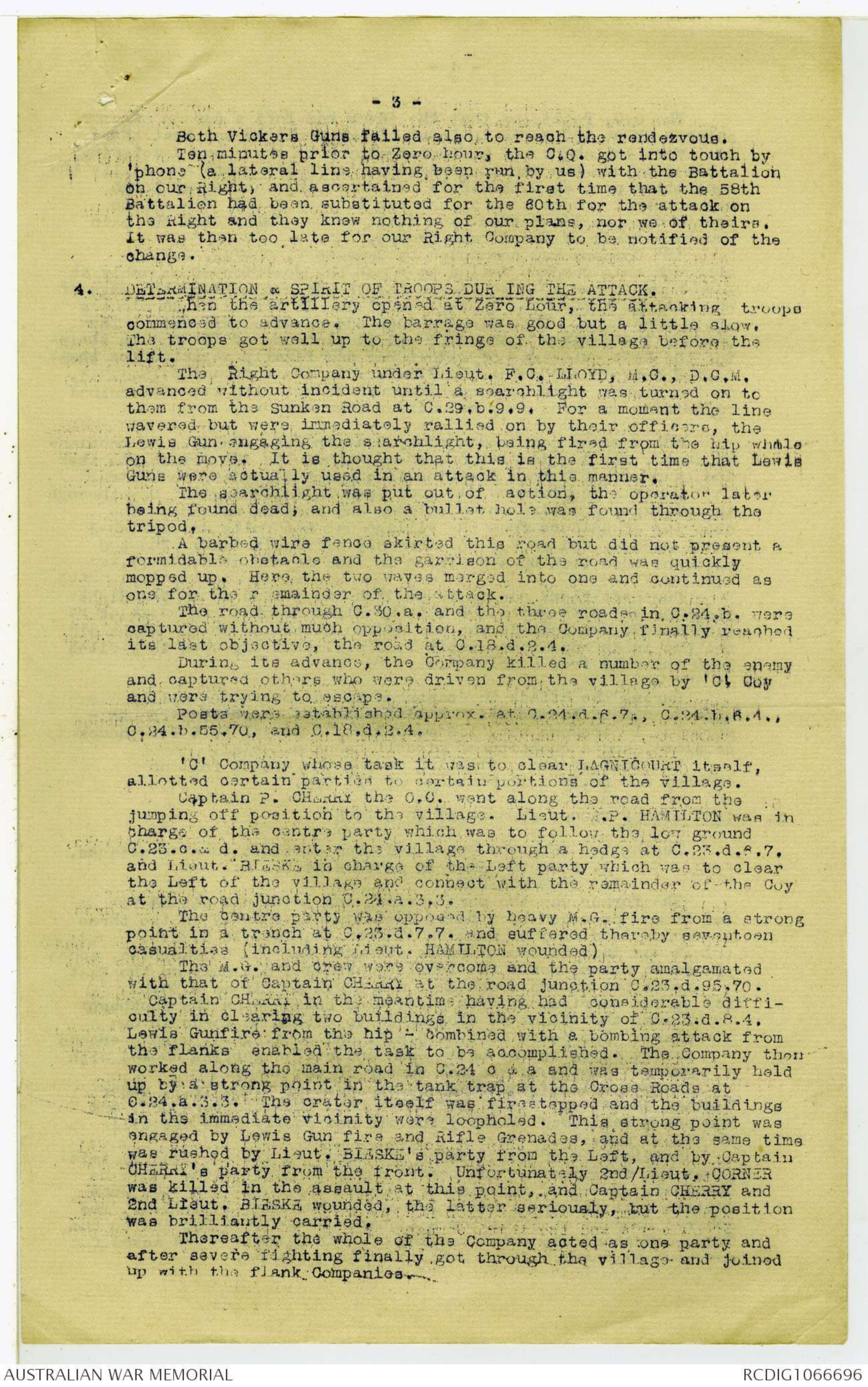
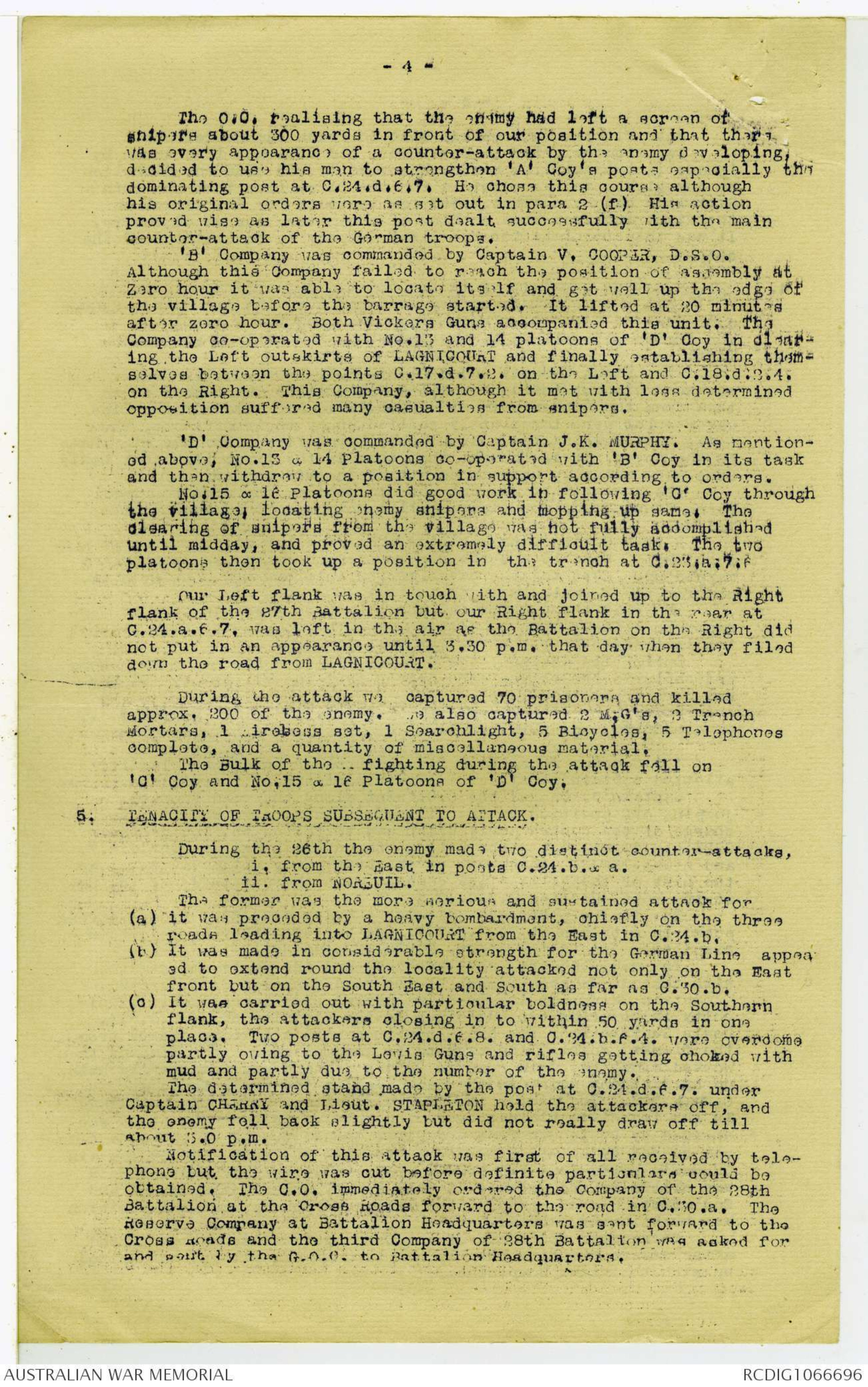
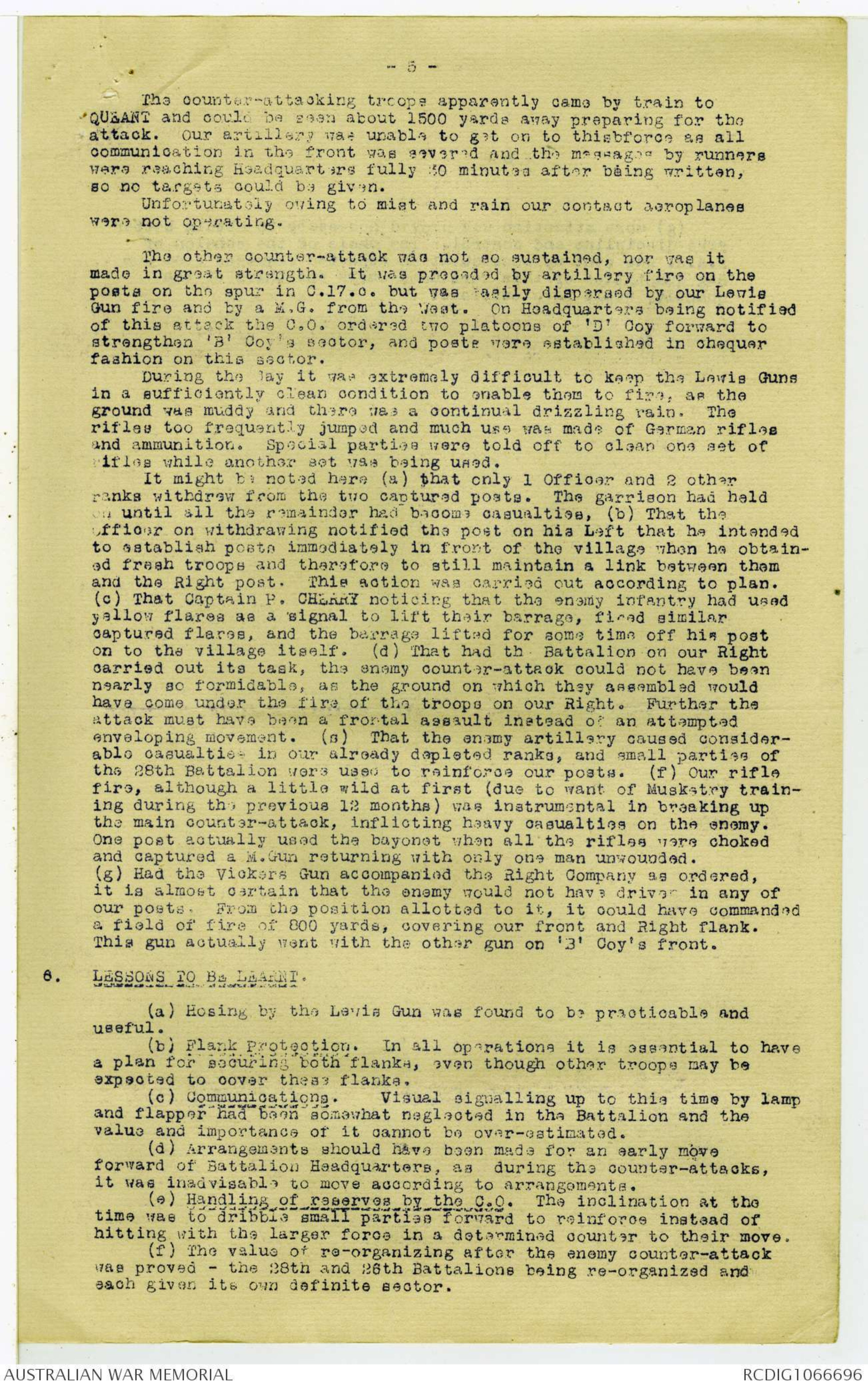
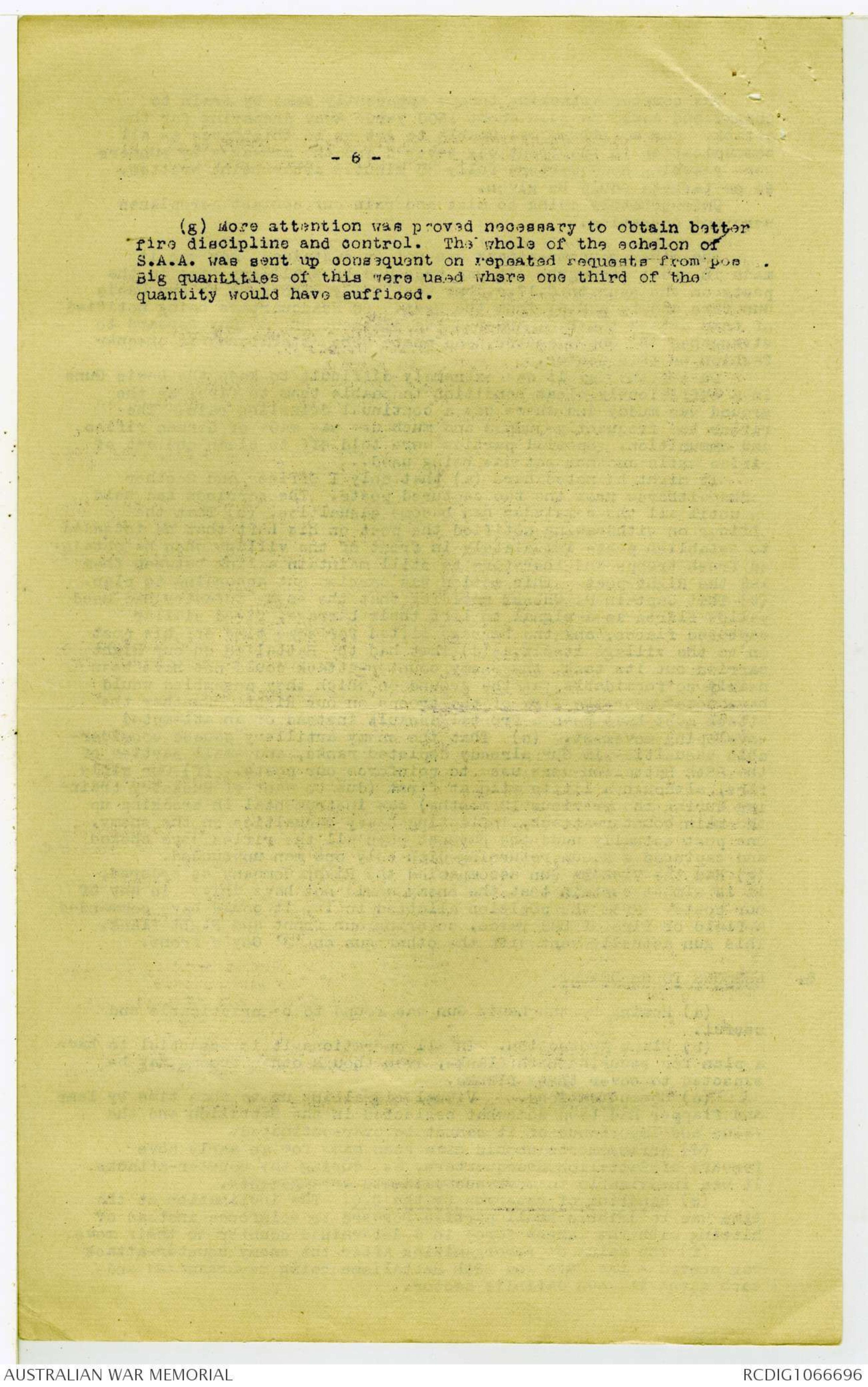
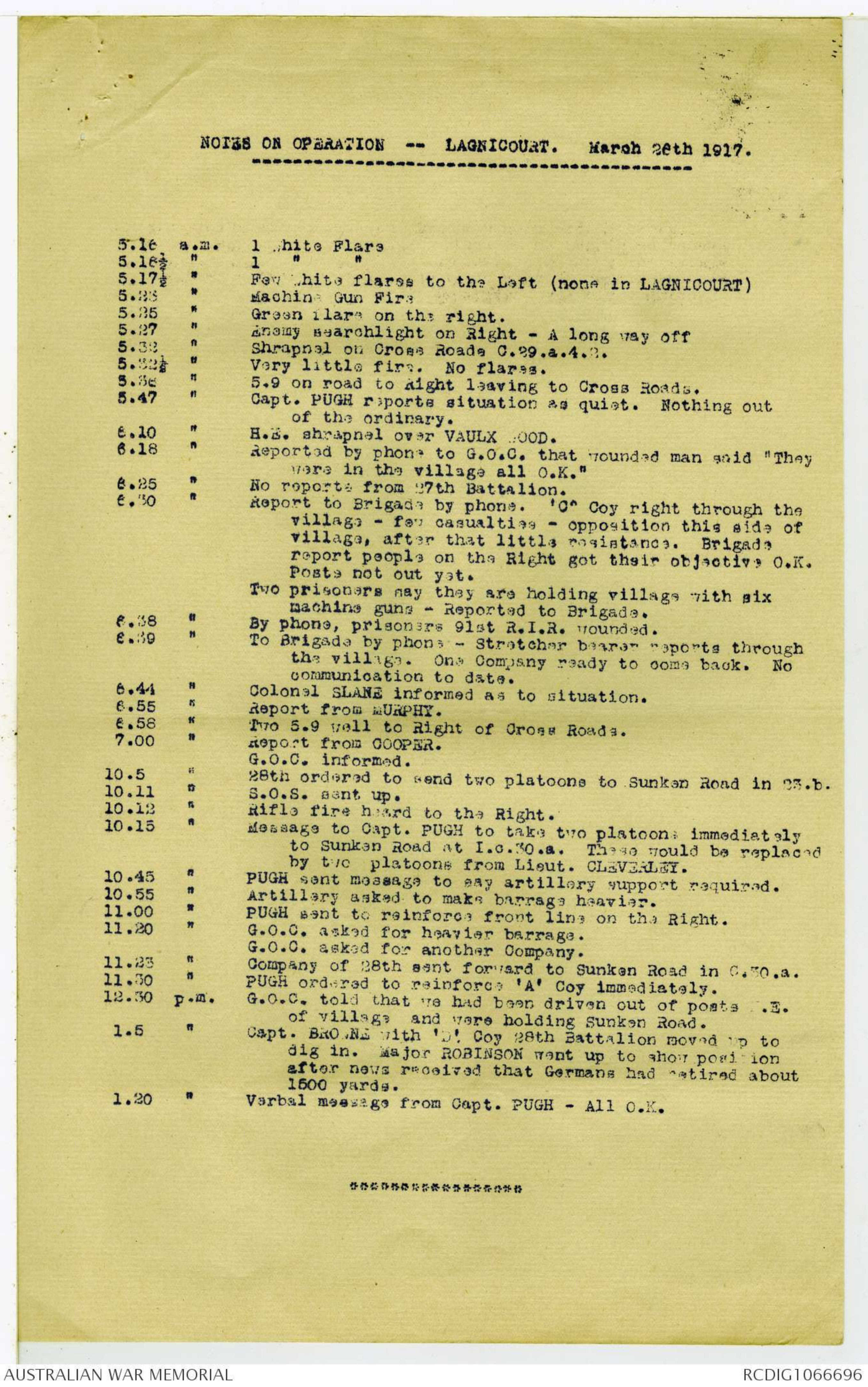
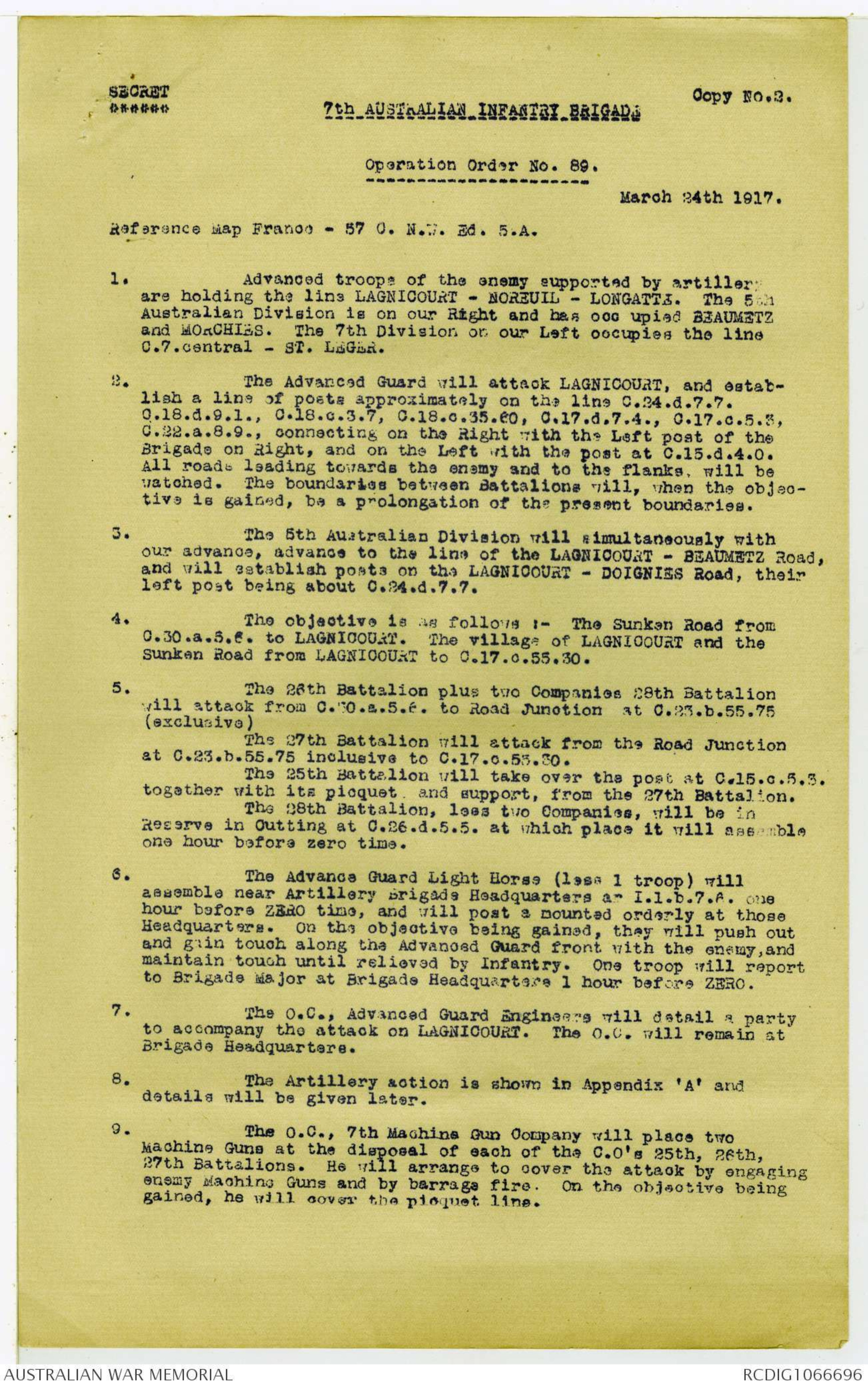
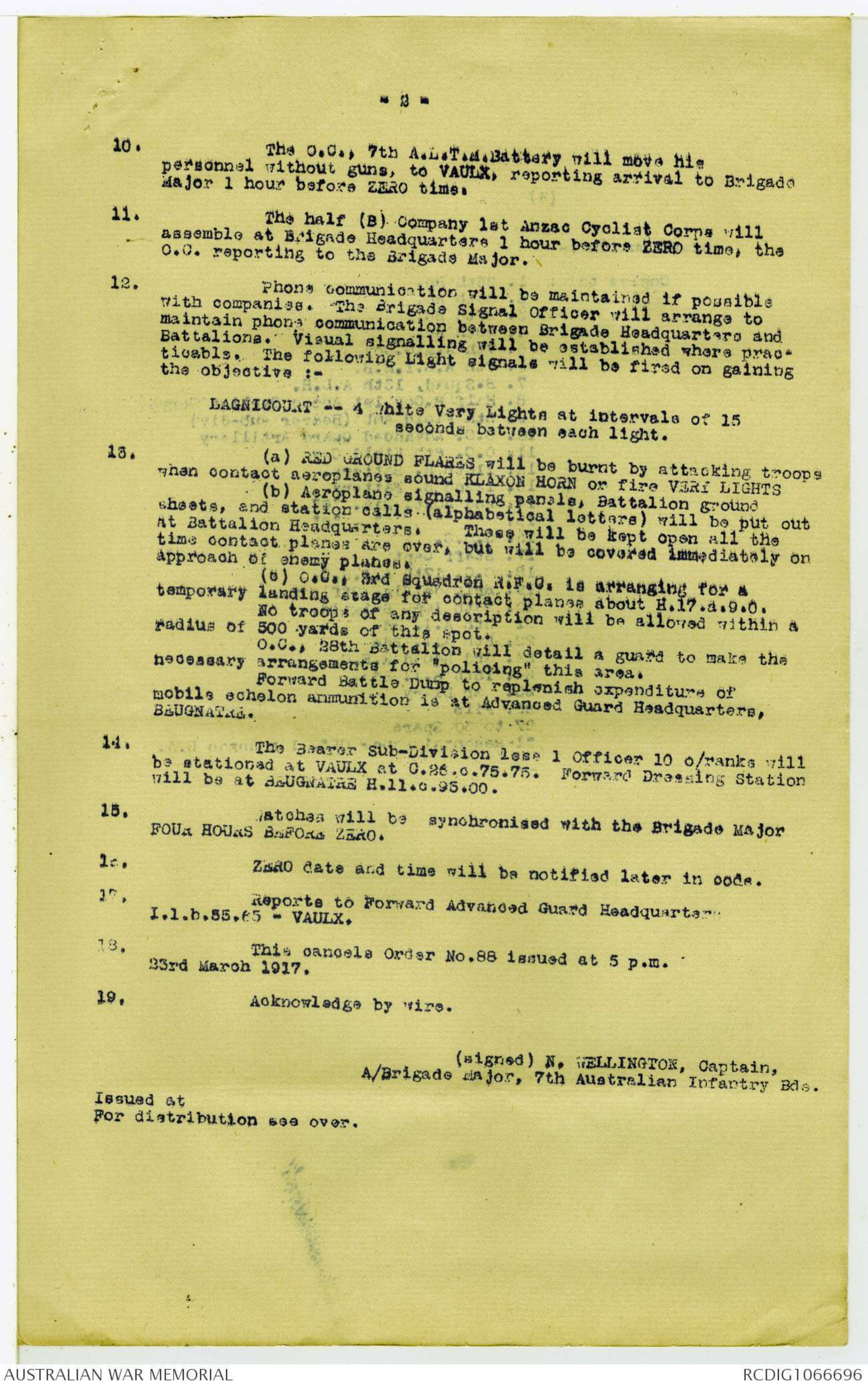
4607.
25 June 1929.
Dear Crowther,
Many thanks for your assistance, which is very
useful. I have made my notes and am returning to you the
documents herewith. We have also noted that you will be
able to assist us when we come to the Allenville affair,
and possibly before then also.
Yours sincerely,
P.S. One point - do you remember if you deployed
the leading company (Captain Jones)? Sale, who
was with the third company, says that he was in
fours when the head of the battalion was fired
into, and then deployed his company on the right
of the road.
Lieutenant-Colonel H.A. Crowther, D.S.O.,
The Lea
Hillston,
via Temora,N.S.W.
26th BATTALION, A.I.F.
BATTLE OF LAGNICOURT. March 26th 1917.
1. The success of the operations at LAGNICOURT on the 26th
March was due to:-
i. Excellent preliminary arrangements,
ii. Determination and spirit of the troops during the
attack,
iii. Tenacity of troops subsequent to the attack.
2. PRELIMINARY ARRANGEMENTS.
(a) It was considered advisable to alter the line of posts
taken, over by the Battalion on the night 20/21st March in order
to secure a better field of fire, and more important - to obtain
better observation of the ground occupied by the enemy. The
change of line is indicated in attached sketch.
(b) A strong effort was made to locate accurately the enemy
outpost line prior to the 26th. The means adopted to make this
effort successful were the following:-
i. Vigorous patrol work by night was organised and
carried out. The orders given to these patrols were to proceed
forward until fired on by the enemy.
ii. Enemy post at Cross Roads at C.20.a.4.2. was seized
by the 15th L.H. and immediately after, garrisoned by a platoon.
iii. Daylight reconnaissance from various observation posts
on road running N.W. and S.E. through Cross Roads.
iv. Close liaison with the R.F.C. who supplied aerial
photographs of the village and made special reconnaissance of enemy
defences and also confirmed information which our patrols supplied.
The airmen reported personally to Battalion Headquarters to discuss
the defences of the village:
v. Daily Conferences of Company Commanders and M.G.O.
arranged by the C.0. to discuss patrol reports, aeroplane photographs
and result of daylight reconnaissances.
(c) All information was made available from the C.O. to
Company Commanders thence to Platoon Commanders, and thence to
every N.C.O. and man. Diagrams were used largely to illustrate
to the men the formation of the village, the probable points of
resistance and the extent of the attack.
(d) Liaison with the flanks received the necessary attention.
The C.O. personally got into touch with the C.O. of the 60th
Battalion on the Right while the Company Commanders of the flank
Companies of the two Battalions made a daylight reconnaissance
together.
(e) A Company of the 28th Battalion attached to the 26th
Battalion, supplied a party to take up a position in NO MANS LAND
covering the place of assembly for our troops, viz. the road
running N.W. and S.E.. through Cross Roads at C.20.a.4.2. This
party also, prior to the attack, was ordered to seize and hold the
enemy M.G. position on the road at C.29.b.05.95.
(f) The plan of attack briefly was for two Companies (A' & 'B
to fringe the flanks of the village and finally to envelop same
while a third Company ('C') want through the village to clear it
and finally to withdraw to Sunken Road in C.29.b.
The Fourth Company ('D') was to act as close support to
'C', to mop up and then withdraw to position S.W. of the village
C.33.d.65.70.
'C' & 'D' Companies were than to act as Supports for 'A'
& 'B" after consolidation.
- 2 -
The 28th Battalion Company attached, was to hold the road
running N.W. and S.E. of Cross Roads at C.29.a.4.2. as a second
support, and a second Company of the 28th Battalion was in
reserve in the vicinity of Battalion Headquarters at
This last mentioned Company also established a Battle Dump at
C.29.a.4.2.
The 27th Battalion on the Left was to swing its Right
flank forward to conform to the movements of our Left attacking
Company.
The 6Oth Battalion on the Right was to occupy the road
running C.30.d. and send troops N.E. of this to road which runs
S.E. from approximately C.24.central.
Two Vickers Guns from the 7th M.G.Coy wer e attached to the
Battalion for the attack, to go over with the second wave of the
flank Companies of the Battalion and establish posts at junction
of roads at C.24.b.1.3. and at C.17.d.8.2. respectively.
The task of the Artillery is indicated in Brigade Order
attached.
A section of the 6th Field Company Engineers was to accompany
the troops to deal with any obstacle which might be encountered.
The road running S.E. & N.W. from Cross Roads at C.29.a.4.2.
was chosen as the position of assembly and the troops were to be
in this position at 4.30 a.m.
(g) ORGANIZATION.
i. How equipped. Each man carried 170 rounds of S.A.A.
and two bombs (No.33) the rods being carried in the putties. Each
Company carried 20 shovels and 5 picks. In addition, ground
flares, S.O.S. rocket signals and telephones with wire carried by
'A' and 'B' Companies.
To each Lewis Gun a sling was attached to enable the
gunner to fire from the hip while on the move.
ii. Formations.
'A', 'B' & 'C' Companies were to attack in two waves
each of lines in accordance with the 'Normal Formation' as laid
down. 'D' Company as "Moppers up" ware to go across in lines
of sections in close support to 'C' Company.
iii. Frontages.
'A' Coy's Left flank rested on Cross Roads at C.29.a.4.2.
'C' Coy's Right " " " " "
'B' Coy was to form up in Sunken Road at C.28.b.9.9.
'D' Coy was to form up in rear of 'C' Coy.
3. INCIDENTS JUST PRIOR TO THE ATTACK.
(1) At dusk, a Company of the 28th Battalion took over the
post at the Cross Roads at C.29.a.4.2. and by 9.30 p.m. on the
25th had pushed out patrols to cover the assembly of the attacking
troops. This action was considered necessary to prevent any
enemy patrol work which might result in the disclosure of our
attack. They also seized the M.G. night position mentioned in
para 2 (c) Had this position not been seized prior to Zero hour
arrangements had been made with the G.O.C. Brigade to have a
howitzer turned on to it for three minutes at Zero hour.
(2) Unfortunately the night of 25/26th was extremely dark,
so much so that every party which attempted to move was lost.
Only a few prismatic compasses were available, but it is doubtful
whether these would have been of any use further than to give a
general direction. It was impossible to see a yard ahead. It is
not surprising therefore that the Battalion on our Right was not
on the jumping off line agreed upon, nor had 'B' Coy reached its
position of assembly.
The 2nd in Command, who was supervising the forming up,
ordered two platoons of 'D' Company to take 'B" Coy's place, and
the Company Commander on the Right extended his men to five paces
instead of three as previously arranged, and sent his first wave
across in one line instead of two to minimise the gap.
- 3 -
Both Vickers Guns failed also, to reach the rendezvous.
Ten minutes prior to Zero hour, the C.0. got into touch by
'phone (a lateral line having been run by us) with the Battalion
on our Right, and ascertained for the first time that the 58th
Battalion had been substituted for the 60th for the attack on
the Right and they knew nothing of our plans, nor we of theirs.
It was then too late for our Right Company to be notified of the
change.
4. DETERMINATION & SPIRIT OF TROOPS DURING THE ATTACK.
When the artillery opened at Zero hour, the attacking troops
commenced to advance. The barrage was good but a little slow.
The troops got well up to the fringe of the village, before the
lift.
The Right Company under Lieut. F.C. LLOYD, M.G., D.C.M.
advanced without incident until a searchlight was turned on to
them from the Sunken Road at C.29.b.9.9. For a moment the line
wavered but were immediately rallied on by their officers, the
Lewis Gun engaging the searchlight, being fired from the hip while
on the move. It is thought that this is the first time that Lewis
Guns were actually used in an attack in this manner.
The searchlight was put out of action, the operator later
being found dead, and also a bullet hole was found through the
tripod.
A barbed wire fence skirted this road but did not present a
formidable obstacle and the garrison of the road was quickly
mopped up. Here the two waves merged into one and continued as
one for the remainder of the attack.
The road through C.30.a. and the three roads in,C.24.b. were
captured without much opposition, and the Company finally reached
its last objective, the road at C.18.d.2.4.
During its advance, the Company killed a number of the enemy
and captured others who were driven from the village by 'C' Coy
and were trying to escape.
Posts were established approx. at C.24.d.6.7., C.24.b.6.4.,
C.24.b.55.70, and C.18.d.2.4.
'C' Company whose task it was to clear LAGNICOURT itself,
allotted certain parties to certain portions of the village.
Captain P. CHERRY the O.C. want along the road from the
jumping off position to the village. Lieut. P. HAMILTON was in
charge of the centre party which was to follow the low ground
C.23.c.& d. and enter the village through a hedge at C.23.d.6.7.
and Lieut. BIESKE in charge of the Left party which was to clear
the Left of the village and connect with the remainder of the Coy
at the road junction C.24.a.3.3.
The centre party was opposed by heavy M.G. fire from a strong
point in a trench at C.23.d.7.7. and suffered thereby seventeen
casualties (including Lieut. HAMILTON wounded)
The M.G. and crew were overcome and the party amalgamated
with that of Captain CHERRY at the road junction C.23.d.95.70.
Captain CHERRY, in the meantime having had considerable difficulty
in clearing two buildings in the vicinity of C.23.d.8.4.
Lewis Gunfire from the hip - combined with a bombing attack from
the flanks enabled the task to be accomplished. The Company then
worked along the main road in C.24 c & a and was temporarily held
up by a strong point in the tank trap, at the Cross Roads at
C.24.a.3.3.. The crater itself was firestopped and the buildings
in the immediate vicinity were loopholed. This strong point was
engaged by Lewis Gun fire and Rifle Grenades, and at the same time
was rushed by Lieut, BIESKE's party from the Left, and by Captain
CHERRY's party from the front. Unfortunately 2nd/Lieut, CORNER
was killed in the assault, at this point, and Captain CHERRY and
2nd Lieut. BIESKE wounded, the latter seriously, but the position
was brilliantly carried.
Thereafter the whole of tha Company acted as one party and
after severe fighting finally got through the village and joined
up with the flank Companies.
- 4 -
The C.O. realising that the enemy had left a screen of
snipers about 300 yards in front of our position and that there
was every appearance, of a counter-attack by the enemy developing,
decided to use his men to strengthen 'A' Coy's posts especially the
dominating post at C.24.d.6.7. He chose this course although
his original orders were as set out in para 2 (f) His action
proved wise as later this post dealt successfully with the main
counter-attack of the German troops.
'B' Company was commanded.by Captain V. COOPER, D.S.O.
Although this Company failed to reach the position of assembly at
Zero hour it was able to locate itself and get well up the edge of
the village before the barrage started. It lifted at 20 minutes
after zero hour. Both Vickers Guns accompanied this unit. The
Company co-operated with No. 13 and 14 platoons of 'D' Coy in clearing
the Left outskirts of LAGNICOURT and finally establishing themselves
between the points C.17.d.7.2. on the Left and C.18.d.3.4.
on the Right. This Company, although it met with less determined
opposition suffered many casualties from snipers.
'D' Company was commanded by Captain J.K. MURPHY. As mentioned
above; No.13 & 14 Platoons co-operated with 'B' Coy in its task
and than withdrew to a position in support according to orders.
No.15 & 16 Platoons did good work in following 'C' Coy through
the village, locating enemy snipers and mopping up same. The
clearing of snipers from the village was not fully accomplished
until midday, and proved an extremely difficult task. The two
platoons then took up a position in the trench at C.23.a.7.6
Our Left flank was in touch with and joined up to the Right
flank of the 27th Battalion but our Right flank in the rear at
C.24.a.6.7, was left in the air as the Battalion on the Right did
not put in an appearance until 3.30 p.m. that day when they filed
down the road from LAGNICOURT:
During the attack we captured 70 prisoners and killed
approx. 200 of the enemy. We also captured 2 M;G's, 2 Trench
Mortars, 1 wireless set, 1 Searchlight, 5 Bicycles, 5 Telephones
complete, and a quantity of miscellaneous material,
The Bulk of the fighting during the attack fell on
'C' Coy and No.15 & 16 Platoons of 'D' Coy.
5. TENACITY OF TROOPS SUBSEQUENT TO ATTACK.
During the 26th the enemy made two distinct counter-attacks,
i. from the East in posts C.24.b.& a.
ii. from NOREUIL.
The former, was the more serious and sustained attack for
(a) it was produced by a heavy bombardment, chiefly on the three
roads leading into LAGNICOURT from the East in C.24.b.
(b) It was made in considerable strength for the German Line appeared
to extend round the locality attacked not only on the East
front but on the South East and South as far as C.30.b.
(c) It was carried out with particular boldness on the Southern
flank, the attackers closing in to within 50 yards in one
place. Two posts at C.24.d.6.8. and C.24.b.6.4. were overcome
partly owing to the Lewis Guns and rifles getting choked with
mud and partly due to, the number of the enemy.
The determined stand made by the post at C.24.d.6.7. under
Captain CHERRY and Lieut. STAPLETON held the attackers off, and
the enemy fell back slightly but did not really draw off till
about 3.0 p.m.
Notification of this attack was first of all received by telephone
but the wire was cut before definite particulars could be
obtained. The C.O. immediately ordered the Company of the 28th
Battalion, at the Cross Roads forward to the road in C.30.a. The
Reserve Company at Battalion Headquarters was sent forward to the
Cross Roads and the third Company of 28th Battalion were asked for
and sent by the G.O.C. to Battalion Headquarters.
-5-
The counter-attacking troops apparently came by train to
QUEANT and could be seen about 1500 yards away preparing for the
attack. Our artillery was unable to gat on to thisbforce as all
communication in the front was severed and the messages by runners
were reaching Headquarters fully 30 minutes after being written,
so no targets could be given.
Unfortunately owing to mist and rain our contact aeroplanes
were not operating.
The other counter-attack was not so sustained, nor was it
made in great strength. It was preceded by artillery fire on the
posts on the spur in C.17.c. but was easily dispersed by our Lewis
Gun fire and by a M.G. from the West. On Headquarters being notified
of this attack the C.O. ordered two platoons of 'D' Coy forward to
strengthen 'B' Coy's sector, and posts ware established in chequer
fashion on this sector.
During the day it was extremely difficult to keep the Lewis Guns
in a sufficiently clean condition to enable them to fire, as the
ground was muddy and there was a continual drizzling rain. The
rifles too frequently jumped and much use was made of German rifles
and ammunition. Special parties were told off to clean one set of
rifles while another set was being used.
It might b: noted hare (a) that only 1 Officer and 2 other
ranks withdrew from the two captured posts. The garrison had held
until all the remainder had become casualties, (b) That the
officer on withdrawing notified the post on his Left that he intended
to establish posts immediately in front of the village when he obtained
fresh troops and therefore to still maintain a link between them
and the Right post. This action was carried out according to plan.
(c) That Captain P. CHERRY noticing that the enemy infantry had used
yellow flares as a signal to lift their barrage, fired similar
captured flares, and the barrage lifted for some time off his post
on to the village itself. (d) That had the Battalion on our Right
carried out its task, the enemy counter-attack could not have bean
nearly so formidable, as the ground on which they assembled would
have come under the fire of the troops on our Right. Further the
attack must have been a frontal assault instead of an attempted
enveloping movement. (e) That the enemy artillery caused considerable
casualties in our already depleted ranks, and small parties of
the 28th Battalion were uses to reinforce our posts. (f) Our rifle
fire, although a little wild at first (due to want of Musketry training
during the previous 12 months) was instrumental in breaking up
the main counter-attack, inflicting heavy casualties on the enemy.
One post actually used the bayonet when all the rifles were choked
and captured a M.Gun returning with only one man unwounded.
(g) Had the Vickers Gun accompanied the Right Company as ordered,
it is almost certain that the enemy would not have driven in any of
our posts. From the position allotted to it, it could have commanded
a field of fire of 800 yards, covering our front and Right flank.
This gun actually went with the other gun on 'B' Coy's front.
6. LESSONS TO BE LEARNT.
(a) Hosing by the Lewis Gun was found to be practicable and
useful.
(b) Flank Protection. In all operations it is essential to have
a plan for securing both flanks, even though other troops may be
expected to cover these flanks.
(c) Communications. Visual signalling up to this time by lamp
and flapper had been somewhat neglected in the Battalion and the
value and importance of it cannot be over-estimated.
(d) Arrangements should have been made for an early move
forward of Battalion Headquarters, as during the counter-attacks,
it was inadvisable to move according to arrangements.
(e) Handling of reserves by the C.O. The inclination at the
time was to dribble small parties forward to reinforce instead of
hitting with the larger force in a determined counter to their move.
(f) The value of re-organizing after the enemy counter-attack
was proved - the 28th and 26th Battalions being re-organized and
each given its own definite sector.
-6 -
(g) More attention was proved necessary to obtain better
fire discipline and control. The whole of the echelon of
S.A.A. was sent up consequent on repeated requests from pos
Big quantities of this were used where one third of the
quantity would have sufficed.
NOTES ON OPERATION -- LAGNICOURT. March 28th 1917.
----------------------------------------------------------------------
| 5.16 | am | 1 white flare |
| 5.16 | " | 1 " " |
| 5.15 | " | Few white flares to the Left (none in LAGNICOURT) |
| 5.23 | " | Machine Gun Fire |
| 5.25 | " | Green flares on the right |
| 5.27 | " | Enemy searchlight on Right - a long way off |
| 5.32 | " | Shrapnel on Cross Roads C.29.a.4.2. |
| 5.36 | "" | 5.9 on road to Right leaving the Cross Roads. |
| 5.47 | " | Capt. PUGH reports situation as quiet. Nothing out of the ordinary. |
| 6.10 | " | H.E. shrapnel over VAULX WOOD |
| 6.18 | " | deported by phone to G.O.C. that wounded man said "They were in the village all O.K." |
| 6.25 | " | No reports from 27th Battalion. |
| 6.30 | " | Report to Brigade by phone. 'C" Coy right through the village - few casualties - opposition this side of village, after that little resistance. Brigade report people on the Right got their objective O.K. Posts not out yet. Two prisoners say they are holding village with six machine guns - Reported to Brigade. |
| 6.38 | " | By phone, prisoners 91st R.I.R. wounded. |
| 6.39 | " | To Brigade by phone - Stretcher bearer reports through the village. One Company ready to come back. No communication to date. |
| 6.44 | " | Colonel SLANE advised as to situation. |
| 6.55 | " | Report from Murphy. |
| 6.58 | " | Two 5.9 well to Right of Cross Roads. |
| 7.00 | " | Report from COOPER. G.O.C. informed. |
| 10.5 | " | 28th ordered to send two platoons to Sunken Road in 23.b. |
| 10.11 | " | S.O.S. sent up. |
| 10.12 | " | Rifle fire hard to the Right. |
| 10.15 | " | Message to Capt. PUGH to take two platoons immediately to Sunken Road at I.c.30.a. These would be replaced by two platoons from Lieut. CLEVERLEY. |
| 10.45 | " | PUGH sent message to say artillery support required. |
| 10.55 | " | Artillery asked to make barrage heavier. |
| 11.00 | " | PUGH sent to reinforce front line on the Right. |
| 11.20 | " | G.O.C. asked for heavier barrage. G.O.C. asked for another Company. |
| 11.23 | " | Company of 28th sent forward to Sunken Road in C.30.a. |
| 11.30 | " | PUGH ordered to reinforce 'A' Coy immediately. |
| 12.30 | p.m. | G.O.C. told that we had been driven out of posts .E. of village and were holding Sunken Road. |
| 1.5 | " | Capt. BROWNE with 'D' Coy 28th Battalion moved up to dig in. Major ROBINSON went up to show position after news received that Germans had retired about 1500 yards. |
| 1.20 | " | Verbal message from Capt. PUGH - All O.K. |
****************
SECRET 7TH AUSTRALIAN INFANTRY BRIGADE Copy No.2.
Operation Order No. 89.
March 24th 1917.
Reference Map France - 57 C. N.W. Ed. 5.A.
1. Advanced troops of the enemy supported by artillery
are holding the line LAGNICOURT - NOREUIL - LONGATTE. The 5th
Australian Division is on our Right and has occ upied BEAUMETZ
and MORCHIES. The 7th Division on our Left occupies the line
C.7.central - ST. LEGER.
2. The Advanced Guard will attack LAGNICOURT, and establish
a line of posts approximately on the line C.24.d.7.7.
C.18.d.9.1., C.18.c.3.7, C.18.c.35.60, C.17.d.7.4., C.17.c.5.3,
C.22.a.8.9., connecting on the Right with the Left post of the
Brigade on Right, and on the Left with the post at C.15.d.4.0.
All roads leading towards the enemy and to the flanks, will be
watched. The boundaries between Battalions will, when the objective
is gained, be a prolongation of the present boundaries.
3. The 5th Australian Division will simultaneously with
our advance, advance to the line of the LAGNICOURT - BEAUMETZ Road,
and will establish posts on the LAGNICOURT - DOIGNIES Road, their
left post being about C.24.d.7.7.
4. The objective is as follows :- The Sunken Road from
C.30.a.5.6. to LAGNICOURT. The village of LAGNICOURT and the
Sunken Road from LAGNICOURT to C.17.0.55.30.
5. The 26th Battalion plus two Companies 28th Battalion
will attack from C.30.a.5.6. to Road Junction at C.23.b.55.75
(exclusive)
The 27th Battalion will attack from the Road Junction
at C.23.b.55.75 inclusive to C.17.c.55.30.
The 25th Battalion will take over the post at C.15.c.5.3.
together with its picquet, and support, from the 27th Battalion.
The 28th Battalion, less two Companies, will be in
Reserve in Outting at C.26.d.5.5. at which place it will assemble
one hour before zero time.
6. The Advance Guard Light Horse (less 1 troop) will
assemble near Artillery Brigade Headquarters at I.1.b.7.6. one
hour before ZERO time, and will post a mounted orderly at those
Headquarters. On the objective being gained, they will push out
and gain touch along the Advanced Guard front with the enemy, and
maintain touch until relieved by Infantry. One troop will report
to Brigade Major at Brigade Headquarters 1 hour before ZER0.
7. The O.C., Advanced Guard Engineers will detail a party
to accompany the attack on LAGNICOURT. The O.C. will remain at
Brigade Headquarters.
8. The Artillery action is shown in Appendix 'A' and
details will be given later.
9. The O.C., 7th Machine Gun Company will place two
Machine Guns at the disposal of each of the C.O's 25th, 26th,
27th Battalions. He will arrange to cover the attack by engaging
enemy Machine Guns and by barrage fire. On the objective being
gained, he will cover the picquet line.
-2-
10. The O.C., 7th A.L.T.M. Battery will move his
personnel without guns, to VAULX, reporting arrival to Brigade
Major 1 hour before ZER0 time.
11. The half (B) Company 1st Anzac Cyclist Corps will
assemble at Brigade Headquarters 1 hour before ZER0 time, the
O.C. reporting to the Brigade Major.
12. Phone communication will be maintained if possible
with companies. The Brigade Signal Officer will arrange to
maintain phone communication between Brigade Headquarters and
Battalions. Visual signalling will be established where practicable.
The following Light signals will be fired on gaining
the objective:-
LAGNICOURT -- 4. White Very lights at intervals of 15
seconds between each light.
13. (a) RED GROUND FLARES will, be burnt by attacking troops
when contact aeroplanes sound KLAXON HORN or fire VERY LIGHTS
(b) Aeroplane signalling panels, Battalion ground
sheets, and station calls (alphabetical letters) will be put out
At Battalion Headquarters. These will be kept open all the
time contact planes are over but will be covered immediately on
Approach of enemy planes.
(c) O.C. 3rd Squadron R.F.C. is arranging for a
temporary landing stage for contact planes about H.17.a.9.0.
No troops of any description will be allowed within a
radius of 500 yards of this spot.
O.C., 28th Battalion will detail a guard to make the
necessary arrangements for "policing" this area.
Forward Battle Dump to replenish expenditure of
mobile echelon ammunition is at Advanced Guard Headquarters,
BEUGNATRE.
14. The Bearer Sub-Division less 1 Officer 10 o/ranks will
be stationed at VAULX at C.24.c.75.75. Forward Dressing Station
will be at BEUGNATRE H.11.c.95.00.
15. Watches will be synchronised with the Brigade Major
FOUR HOURS BEFORE ZER0.
16. Zero date and time will be notified later in code.
17. Reports to Forward Advanced Guard Headquarters
I.1.b. 55.65 - VAULX.
18. This cancels Order No.88 issued at 5 p.m.
23rd March 1917.
19. Acknowledge by wire.
(signed) N. WELLINGTOK, Captain,
A/Brigade Major, 7th Australian Infantry Bde.
Issued at
For distribution see over.
 Sam scott
Sam scottThis transcription item is now locked to you for editing. To release the lock either Save your changes or Cancel.
This lock will be automatically released after 60 minutes of inactivity.